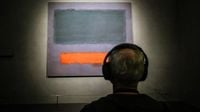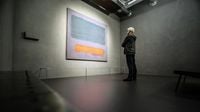A painting worth tens of millions of euros was damaged at the Museum Boijmans van Beuningen in Rotterdam after a child touched it, resulting in scratches on the canvas. The incident occurred on Friday, April 25, 2025, and has drawn attention to the vulnerabilities of valuable artworks in public spaces.
The artwork in question is titled Grey, Orange on Maroon, No 8, created by the renowned American artist Mark Rothko. This significant piece measures 2.3 by 2.6 meters and was acquired by the museum in 1970. Valued between 40 and 50 million euros, it is one of only two Rothko paintings in Dutch collections, making it a crucial part of the museum's offerings.
According to a spokesperson for the museum, the damage occurred during an "unattended moment" earlier this year. The scratches, which are located on the lower part of the painting, were confirmed by museum staff who noticed the issue while the artwork was on display. The museum had included the painting in its recent exhibition titled Lievelingen XL, which showcased six artworks of enormous dimensions from March 2 to April 6, 2025.
Following the incident, the museum promptly removed the painting from public view. Experts are currently assessing the extent of the damage and exploring options for restoration. However, the museum has not disclosed whether the repair costs will be covered by insurance or if the responsibility will fall on the child’s guardians.
The incident has sparked discussions about the safety measures in place for protecting high-value artworks. This is not the first time Grey, Orange on Maroon, No 8 has faced potential threats; in 2019, a man threatened to damage the painting while it was on display at the Stedelijk Museum Schiedam, leading to heightened security measures at that time.
Art institutions often grapple with the challenge of balancing public access to artworks with the need to protect these valuable pieces from accidental damage. Museum officials have expressed their commitment to ensuring that such incidents are minimized in the future.
As the investigation into the damage continues, the museum remains tight-lipped about the specifics of the restoration process and its costs. The spokesperson declined to comment on whether the situation would be treated as an insurance matter, a common practice in the art world when dealing with damage to priceless works.
The incident highlights the fragility of art in public spaces and raises questions about how museums can better safeguard their collections. With the increasing popularity of immersive art exhibitions, the need for robust protective measures has never been more pressing.
In the wake of this event, it is essential for museums to reevaluate their policies regarding visitor interaction with artworks, especially those of immense value. Some institutions have already implemented strict guidelines, including barriers or glass cases for particularly vulnerable pieces.
As the art community watches closely, the outcome of this incident may set a precedent for how similar situations are handled in the future. The museum's response will likely influence public perception of the institution's commitment to preserving cultural heritage while still engaging audiences.
In the meantime, the museum has expressed its hope that the painting can be restored to its former glory. Rothko's works are known for their emotional depth and vibrant colors, and Grey, Orange on Maroon, No 8 is no exception. The painting's value is not only monetary but also cultural, representing a significant moment in the history of modern art.
As experts evaluate the damage, the museum is also considering how to communicate with the public about the incident. Transparency will be key in maintaining trust with visitors who may be concerned about the safety of artworks during their visits.
In conclusion, while the damage to Grey, Orange on Maroon, No 8 is unfortunate, it serves as a critical reminder of the need for continued vigilance in protecting our cultural treasures. As the museum navigates this challenging situation, it will be imperative to balance accessibility with the protection of valuable artworks, ensuring that future generations can continue to appreciate the profound impact of artists like Rothko.





